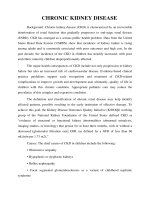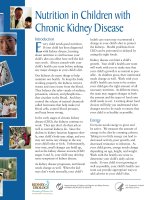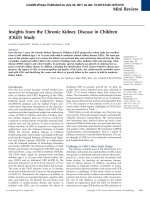Novel Insights on Chronic Kidney Disease, Acute Kidney Injury and Polycystic Kidney Disease Edited by Soundarapandian Vijayakumar pdf
Bạn đang xem bản rút gọn của tài liệu. Xem và tải ngay bản đầy đủ của tài liệu tại đây (2.57 MB, 144 trang )
NOVEL INSIGHTS
ON CHRONIC KIDNEY
DISEASE, ACUTE KIDNEY
INJURY AND POLYCYSTIC
KIDNEY DISEASE
Edited by Soundarapandian Vijayakumar
Novel Insights on Chronic Kidney Disease,
Acute Kidney Injury and Polycystic Kidney Disease
Edited by Soundarapandian Vijayakumar
Published by InTech
Janeza Trdine 9, 51000 Rijeka, Croatia
Copyright © 2012 InTech
All chapters are Open Access distributed under the Creative Commons Attribution 3.0
license, which allows users to download, copy and build upon published articles even for
commercial purposes, as long as the author and publisher are properly credited, which
ensures maximum dissemination and a wider impact of our publications. After this work
has been published by InTech, authors have the right to republish it, in whole or part, in
any publication of which they are the author, and to make other personal use of the
work. Any republication, referencing or personal use of the work must explicitly identify
the original source.
As for readers, this license allows users to download, copy and build upon published
chapters even for commercial purposes, as long as the author and publisher are properly
credited, which ensures maximum dissemination and a wider impact of our publications.
Notice
Statements and opinions expressed in the chapters are these of the individual contributors
and not necessarily those of the editors or publisher. No responsibility is accepted for the
accuracy of information contained in the published chapters. The publisher assumes no
responsibility for any damage or injury to persons or property arising out of the use of any
materials, instructions, methods or ideas contained in the book.
Publishing Process Manager Petra Nenadic
Technical Editor Teodora Smiljanic
Cover Designer InTech Design Team
First published February, 2012
Printed in Croatia
A free online edition of this book is available at www.intechopen.com
Additional hard copies can be obtained from
Novel Insights on Chronic Kidney Disease, Acute Kidney Injury and Polycystic Kidney
Disease, Edited by Soundarapandian Vijayakumar
p. cm.
ISBN 978-953-51-0234-2
Contents
Preface IX
Part 1 Acute and Chronic Kidney Diseases 1
Chapter 1 Congenital Obstructive
Nephropathy: Clinical
Perspectives and Animal Models 3
Susan E. Ingraham and Kirk M. McHugh
Chapter 2 Association Between
Haemoglobin Variability and
Clinical Outcomes in Chronic Kidney Disease 30
Roshini Malasingam, David W. Johnson and Sunil V. Badve
Chapter 3 Complexity of Differentiating
Cerebral-Renal Salt Wasting
from SIADH, Emerging Importance
of Determining Fractional Urate Excretion 41
John K. Maesaka, Louis Imbriano,
Shayan Shirazian and Nobuyuki Miyawaki
Chapter 4 Epidemiology, Causes and
Outcome of Obstetric Acute Kidney Injury 67
Namrata Khanal, Ejaz Ahmed and Fazal Akhtar
Part 2 Polycystic Kidney Diseases 85
Chapter 5 Extracellular Matrix
Abnormalities in Polycystic Kidney Disease 87
Soundarapandian Vijayakumar
Chapter 6 Angiogenesis and the
Pathogenesis of Autosomal
Dominant Polycystic Kidney Disease 93
Berenice Reed and Wei Wang
VI Contents
Part 3 The Renin-Angiotensin-Aldosterone Pathway 111
Chapter 7 The Renin-Angiotensin-
ldosterone System in Dialysis Patients 113
Yoshiyuki Morishita and Eiji Kusano
Chapter 8 Diagnosis and Treatment of Primary Aldosteronism 125
Ozlem Tiryaki and Celalettin Usalan
Preface
Chronic kidney disease (CKD) has been recently recognized by the United Nations as
a major non-communicable disease that poses significant health burden to the world
population. This book offers novel insights on topics such as congenital obstructive
nephropathy, cerebral-renal salt wasting, and the role of hemoglobin variability in
clinical outcomes of CKD which are not very often discussed in the literature. Two
related topics, primary aldosteronism and the role of renin-angiotensin-aldosterone
system in the development of hypertension in CKD patients are also discussed. Acute
Kidney Injury (AKI), characterized by a rapid reduction in kidney function, is more
common in hospitalized patients and is an independent risk factor for mortality. Dr.
Khanal Namrata discusses the epidemiology, causes and outcome of obstetric acute
kidney injury in this book. Polycystic Kidney Diseases (PKD) are a group of genetic
diseases affecting nearly 12 million people worldwide and there has been a significant
interest and progress in the understanding of these diseases. Two often overlooked
topics, the role of extracellular matrix abnormalities in PKD cystogenesis and
progression, and the role of angiogenesis in ADPKD pathogenesis provide critical
insights into these topics. With comprehensive and insightful reviews by eminent
clinicians and scientists in the field, this book is a valuable tool for nephrologists.
Dr. S. Vijayakumar, Ph.D
Pediatric Nephrology
University of Rochester Medical Center
USA
Part 1
Acute and Chronic Kidney Diseases
1
Congenital Obstructive Nephropathy:
Clinical Perspectives and Animal Models
Susan E. Ingraham and Kirk M. McHugh
Department of Pediatrics, Division of Pediatric Nephrology, The Ohio State University
and The Research Institute at Nationwide Children’s Hospital,
Columbus, Ohio,
USA
1. Introduction
Congenital obstructive nephropathy is the leading cause of pediatric chronic kidney disease
(CKD). Consequently, it engenders a tremendous societal burden in terms of morbidity and
mortality and in health care expenses over the lifespan of affected patients. The challenges
clinicians face in the diagnosis, prognosis, and treatment of congenital obstructive
nephropathy illustrate the utility of developing effective experimental models for the study
of this complex disease process. In this review, we characterize congenital obstructive
nephropathy with its myriad causes and manifestations, outline current standards of
diagnosis and care, and discuss experimental animal models with relevance in unraveling
clinical conundrums and molecular mechanisms of this important renal disease.
Congenital obstructive nephropathy is a complex process of pathologic changes in kidney
development and function that arise when antegrade urine flow is impaired beginning in
utero. The term congenital obstructive uropathy is frequently used to describe this condition.
However, every urologic obstruction – whether anatomic, mechanical, or functional –
should be approached with the knowledge that obstruction can affect the kidneys. For this
reason, we prefer the term congenital obstructive nephropathy.
Intrinsic anatomic obstructions may occur in isolation or accompanied by other pathology
such as renal hypodysplasia. Functional obstructions also occur, which may be transient and
self-resolving, or chronic with potentially profound consequences on renal function.
Although the etiologies of congenital obstructive nephropathy are myriad, any restriction of
urine flow has the potential to produce hydronephrosis, altered renal development, and
progression of CKD. This direct link between obstructed urine flow and abnormal kidneys
represents a central paradigm of urogenital pathogenesis that has far-reaching implications
(Woolf & Thiruchelvam, 2001).
2. Epidemiology of congenital obstructive nephropathy
Congenital obstructive nephropathy is the most common cause of CKD in children and is
among the top three etiologies of pediatric end-stage renal disease (ESRD; NAPRTCS, 2009).
Novel Insights on Chronic Kidney Disease, Acute Kidney Injury and Polycystic Kidney Disease
4
Congenital obstructive nephropathy is often grouped with renal agenesis,
hypoplasia/dysplasia and other abnormalities as a heterogeneous entity termed congenital
anomalies of the kidney and urinary tract (CAKUT). CAKUT is relatively common, affecting up
to 2% of pregnancies (Ismaili et al., 2003; Wiesel et al., 2005). CAKUT accounts for 51% of
childhood CKD in North America (NAPRTCS, 2009), and similar frequencies in registry
data from around the world (Neild, 2009a). Among the diagnoses within the broad category
of CAKUT, obstructive disease carries the greatest risk for developing ESRD (Sanna-Cherchi
et al., 2009). The association of renal hypodysplasia and impaired glomerular filtration rate
with urological obstruction is well-established. More subtle renal changes such as
hypertension, impaired sodium/water handling, and acidosis are also common (Farnham et
al., 2005; Gillenwater et al., 1975). Thus the full clinical impact of congenital obstructive
nephropathy is immense.
3. Classification of congenital obstructive nephropathy
The timing, extent, etiology, and location of impaired urine flow are important
considerations in describing and classifying the causes of obstructive nephropathy. One of
the most important and useful distinctions is the anatomic level at which the obstruction
occurs – namely, the upper urinary tract (kidney or ureter) versus the lower urinary tract
(bladder, bladder outlet or urethra). Upper urinary tract lesions have little potential to
affect the contralateral kidney, whereas lower tract anomalies generally put both kidneys
at risk.
3.1 Upper urinary tract obstructions
Congenital obstructions of the upper urinary tract include ureteropelvic junction (UPJ) and
ureterovesical junction (UVJ) obstructions, as well as obstructing ureteroceles and other
anomalies of ureteric structure or position.
3.1.1 Ureteropelvic junction obstruction
UPJ obstruction is the most common congenital urological obstruction (Figure 1). It occurs in
one of every 1000-2000 births, with a 3:1 male predominance. Obstruction is bilateral in 20-
25% of cases (Woodward & Frank, 2002). Congenital UPJ obstructions usually arise from an
adynamic proximal ureteral segment. This dysfunctional segment of the ureter often
exhibits abnormal distribution of collagen and/or smooth muscle, and may show altered
innervation or vasculature (Hosgor et al., 2005; Payabvash et al., 2007; Yoon et al., 1998).
Less common intrinsic causes of UPJ obstruction include a convoluted ureteral course and
deformations of the mucosa, including valve-like folds or polyps. UPJ obstruction may also
arise from extrinsic compression of the proximal ureter by another structure such as
aberrant vasculature or fibrous bands.
3.1.2 Ureterovesical junction obstruction
UVJ obstruction, or primary obstructive megaureter, arises when urine flow is restricted at
or near the insertion of the ureter into the bladder (Figure 2). This is the second most
common site of congenital obstruction, after the UPJ (Brown et al., 1987; Reinberg et al.,
Congenital Obstructive Nephropathy: Clinical Perspectives and Animal Models
5
1991). UVJ obstruction is four times more common in males and arises more often on the
left, with bilateral obstructions occurring in up to 25% of cases (Gimpel et al., 2010;
Woodward & Frank, 2002). Like UPJ obstruction, UVJ obstruction is typically associated
with an adynamic ureteric segment that fails to propagate effective urine flow.
Fig. 1. Radiological findings associated with UPJ obstruction in an 18 month old female. Left
hydronephrosis was detected prenatally, and the patient had normal postnatal renal
function with no vesicoureteral reflux (VUR). She was managed conservatively, with
gradual improvement in hydronephrosis on serial imaging studies through age 15 months.
However, at 18 months of age hydronephrosis worsened. A - C. Ultrasound of urinary
bladder (A), right (B) and left (C) kidneys. The bladder (A) is normal in conformation with
normal wall thickness, and no hydroureter is seen. The right kidney (B) is structurally
normal with slight pelviectasis. The left kidney (C) demonstrates marked hydronephrosis
with blunted calyces and thinned parenchyma, which had worsened from previous findings
of moderate but improving hydronephrosis. D and E. Technetium-99m MAG3 diuretic renal
scan using the F+20 protocol confirmed a left ureteropelvic junction obstruction. Sequential
posterior images of the abdomen and pelvis (D) are grouped into perfusion, parenchymal,
and excretion phases. Ten milligrams of furosemide were administered 20 minutes after
tracer injection. With injection of the tracer, there is bolus visualization of the inferior vena
Novel Insights on Chronic Kidney Disease, Acute Kidney Injury and Polycystic Kidney Disease
6
cava, followed by prompt visualization of renal parenchyma bilaterally. On the right side,
there is prompt cortical transit and accumulation in a normal-caliber collecting system
followed by appropriate washout. Renogram curve (E) shows a normal right drainage half-
time (T
1/2
) of 8.9 minutes. On the left side, the kidney is enlarged with central photopenia
consistent with hydronephrosis. Cortical transit is slightly delayed on the left compared to
the right. In the excretion phase, tracer accumulates in the hydronephrotic collecting system
but there is no washout of the radiopharmaceutical from the left kidney. Left T
1/2
was not
reached in the duration of the study. The patient subsequently underwent left pyeloplasty
for UPJ obstruction.
Fig. 2. Radiological findings associated with UVJ obstruction in a 4 month old male. A - C.
Ultrasound of urinary bladder (A), right (B) and left (C) kidneys. The bladder (BL) is normal
in conformation with a smooth wall of normal thickness. Bilateral distal hydroureter is seen,
greater on the right (RU) than the left (LU). The right kidney (B) is moderately
hydronephrotic with well-preserved parenchyma. The left kidney (C) demonstrates normal
echotexture and no hydronephrosis, but urothelial thickening is seen. D - F. Technetium-
99m MAG3 diuretic renal scan using the F+20 protocol confirmed a right UVJ obstruction.
Sequential posterior images are shown for the excretion phase only (D). Renogram curves
are illustrated for both kidneys (E) as well as for both ureters (F). Appropriate excretion is
observed in the left kidney and ureter both before and after administration of furosemide.
On the right side, minimal excretion is demonstrated prior to and following the diuretic.
Renal T
1/2
is 2.3 minutes on the left and never reached on the right.
Congenital Obstructive Nephropathy: Clinical Perspectives and Animal Models
7
3.1.3 Ureterocele
Ureteroceles are cystic dilations of the submucosal or intravesical segment of a ureter
(Figure 3). If the opening to the ureterocele is stenotic or ectopically positioned,
obstruction often results. The prevalence of ureterocele is 1 in 5000 newborns. Unlike the
majority of obstructive lesions, ureteroceles demonstrate a female predominance
(Woodward & Frank, 2002). Ureteroceles are often associated with a duplex collecting
system and/or ectopic ureteral insertion. Depending on the location, configuration and
size, unilateral ureteroceles may cause bilateral obstruction. Bilateral ureteroceles are
present in 20-50% of cases (Pohl et al., 2007).
Fig. 3. Radiological findings associated with ureterocele in a 6 day old male. A and B.
Voiding cystourethrogram (VCUG). Filling image (A) shows the ureterocele as an ovoid
filling defect (red arrow). Voiding image (B) shows eversion of the ureterocele (yellow
arrow) through an ectopic ureteral insertion, resembling a congenital paraurethral
diverticulum. C – E. Ultrasound of urinary bladder (C), right (D) and left (E) kidneys. The
bladder (BL, image C) is minimally distended but demonstrates smooth walls of normal
thickness. Within the bladder, the thin rounded septation (white arrowhead) delineating the
ureterocele (UC) is seen. A markedly dilated right distal ureter (RU) is also evident on this
lateral, longitudinal view. The right hydroureter is associated with right upper pole
hydronephrosis (RUP, image D) in a duplex right kidney. There is minimal hydronephrosis
in the right lower pole duplex moiety. A duplex kidney is also observed on the left (E), with
no hydronephrosis.
Novel Insights on Chronic Kidney Disease, Acute Kidney Injury and Polycystic Kidney Disease
8
3.1.4 Other upper urinary tract obstructions
Although less common than UPJ or UVJ obstructions, congenital obstructions can arise
elsewhere within the kidney or along the course of the ureter. Examples include
infundibular or infundibulopelvic stenosis, which may be idiopathic or associated with
Beckwith-Wiedemann or Bardet-Biedl syndrome; anomalous ureteric position, such as a
retroiliac or retrocaval course; and mid-ureteral stricture.
3.2 Lower urinary tract obstructions
There are several congenital anomalies that result in chronic lower urinary tract obstruction,
the most familiar being posterior urethral valves (PUV). Other inborn causes of lower
urinary tract obstruction include urethral atresia, stenosis or hypoplasia; anterior urethral
valves; urethral diverticula; and cloacal anomalies. Congenital lower urinary tract
obstructions put both kidneys at risk for abnormalities in fetal renal development and
impaired renal function, and may be associated with oligohydramnios and pulmonary
hypoplasia. Congenital lower urinary tract obstructions may also result in bladder
dysfunction, ultimately leading to a secondary functional obstruction that may require
careful management to optimize renal outcomes.
3.2.1 Posterior urethral valves
PUV, also known as congenital obstructing posterior urethral membrane, is found in 1 out of
5000-8000 live births, and occurs only in males (King, 1985). Oligohydramnios is a common
consequence, and renal dysplasia may also be present. Using postnatal fluoroscopic VCUG,
the gold standard for diagnosis of PUV and other lower urinary tract obstructions
(Riedmiller et al., 2001), the classic finding for PUV is a linear filling defect in the column of
radiocontrast filling a markedly dilated posterior urethra. However, this distinct linear
radiolucent band corresponding to the “valve” is not always seen, because the obstructing
membrane can become distended and take on a more sail-like or windsock appearance, as
shown in Figure 4. Secondary VUR is found in 25-50% of PUV cases (Agarwal, 1999). In a
subset of patients, unilateral VUR may provide a “pop-off” effect, whereby renal tissue and
function on the non-refluxing side is preserved at the expense of severe dysplasia and
dysfunction in the refluxing kidney (Greenfield et al., 1983).
3.2.2 Urethral atresia, stenosis, or hypoplasia
Although PUV is the most common cause of congenital lower urinary tract obstruction
postnatally, detailed postmortem analysis of fetuses with megacystis and hyperechogenic
kidneys showed that isolated severe lower urinary tract obstruction before 25 weeks’
gestation was as likely to be due to urethral atresia or stenosis as PUV (Robyr et al., 2005).
Urethral atresia may arise in association with complex collections of other genitourinary
and/or gastrointestinal anomalies. Moreover, urethral atresia may be a cause of bladder
outlet obstruction in females whereas PUV is not. Urethral atresia is incompatible with life
unless an alternative connection between the bladder and the amniotic sac is present.
Prenatal surgical decompression has been performed to relieve this obstruction, although a
spontaneous fistula or patent urachus may also provide the necessary bladder drainage
Congenital Obstructive Nephropathy: Clinical Perspectives and Animal Models
9
Fig. 4. Radiological findings associated with PUV in a 2 day old male. A - C. Ultrasound of
urinary bladder (A), right (B) and left (C) kidneys. The bladder (BL) is rounded with a
thickened and trabeculated wall. This patient had severe hydroureter bilaterally, although
only the left ureter (LU) is clearly observed in image A. Moderate to severe hydronephrosis
is present bilaterally, with thinning of the cortex, increased echogenicity relative to the liver
(LIV), and poor corticomedullary differentiation. One fluid-filled area (CY) in the right
kidney did not clearly communicate with the collecting system, and likely represents a large
cyst. D and E. VCUG. The lobulated and undulating contours of the urinary bladder (BL)
reflect thickening and trabeculation of the bladder wall. The posterior urethra (PU) is
dilated. Rather than the classic abrupt transition to a normal caliber anterior urethra, this
patient has the “wind-sock” appearance generated by distal prolapse or distention of the
valve membrane (arrow). VUR into a tortuous and dilated left ureter (LU) is obvious.
(Gonzalez et al., 2001; Herndon & Casale, 2002). An association between urethral atresia and
prune belly syndrome has been recognized (Reinberg et al., 1993). Progression to ESRD is
Novel Insights on Chronic Kidney Disease, Acute Kidney Injury and Polycystic Kidney Disease
10
common, although not universal, in surviving patients with urethral atresia (Gonzalez, et
al., 2001).
3.2.3 Prolapsing ureterocele
Large ureteroceles can prolapse through the urethra, which may result in bladder outlet
obstruction. This is most frequently an acquired condition, although rarely prolapse may
occur in utero, leading to features of congenital obstructive nephropathy (Sozubir et al.,
2003).
3.2.4 Other urethral obstructions
Urethral diverticula and anterior urethral valves are rare causes of infravesicular
obstruction. Interestingly, although bladder pathology and variable degrees of
hydroureteronephrosis result, renal function is usually not impaired after surgical correction
of the obstruction (Arena et al., 2009; Gupta & Srinivas, 2000; Rawat et al., 2009).
3.3 Functional obstruction
Functional urological obstructions are conditions that result in impaired antegrade urine
flow without evidence of a physical blockage. In many patients, the situation may be
transient and can ultimately resolve without intervention, in which case a specific etiology
may never be identified. In other cases a functional obstruction may result from myogenic
or neurogenic causes, which can result in lifelong voiding dysfunction as well as significant
renal impairment. Examples include conditions such as congenital neurogenic bladder
(Ewalt & Bauer, 1996), congenital non-neurogenic neurogenic bladder (Vidal et al., 2009),
and prune belly syndrome (Woodhouse et al., 1982).
3.4 Multisystem conditions associated with obstruction or voiding dysfunction
3.4.1 Prune belly syndrome
Prune belly syndrome (Figure 5), also known as Eagle-Barrett syndrome, consists of the
triad of underdeveloped abdominal wall musculature, urinary tract dilatation, and
undescended testicles (Eagle & Barrett, 1950). Postnatally, urinary obstruction in prune
belly syndrome is often functional rather than anatomic in nature. Prune belly syndrome
has an incidence of 3.8 per 100,000 male births (Routh et al., 2010). The condition also
occurs rarely in females, albeit necessarily lacking cryptorchidism (Reinberg, et al., 1991).
Secondary VUR is present in 85% of patients with prune belly syndrome, and associated
anomalies of the gastrointestinal, pulmonary, skeletal, and/or cardiac systems are
common (Strand, 2004).
Two major theories, which are not mutually exclusive, have been advocated regarding the
development of prune belly syndrome. One proposes that the condition arises from a
fundamental flaw in mesoderm development (Straub & Spranger, 1981), while the other
suggests that prune belly syndrome originates from a severe fetal urethral obstruction that
results in massive distention of the bladder, degeneration of the abdominal wall
musculature, and interruption of testicular descent (Pagon et al., 1979).
Congenital Obstructive Nephropathy: Clinical Perspectives and Animal Models
11
Fig. 5. Radiological findings associated with prune belly syndrome in a 2 day old male.
A - E. Ultrasound of urinary bladder (A), right (B) and left (C) ureters, right (D) and left (E)
kidneys. The bladder (BL) is decompressed but bladder wall thickness is normal. Tortuous
dilated ureters (U, RU, LU) are observed bilaterally in the lower abdomen. The kidneys are
dysplastic and amorphous in appearance, with cysts of varying sizes. There is no
corticomedullary differentiation in either kidney. F. VCUG. The protuberant abdomen
resulting from lack of abdominal wall musculature is evident from the position of bowel
loops (arrows) on this lateral view. This patient has an unusual configuration of the bladder,
bladder base and posterior urethra. There is absence of the normal prostate and a very
distended posterior urethra (PU) connecting to a dysplastic-appearing bladder (BL). No
evidence of true PUV was found on this or any subsequent investigations. Reflux is
observed into the distended right ureter (RU) but not the left. G. VCUG from another
patient 10 days postnatally shows a more typical trabeculated bladder with the
characteristic tubular shape of the bladder base in prune belly syndrome.
Novel Insights on Chronic Kidney Disease, Acute Kidney Injury and Polycystic Kidney Disease
12
3.4.2 Spina bifida
Approximately 50% of children with myelomeningocele have detrusor-bladder sphincter
dyssynergy, resulting in a functional bladder outlet obstruction and development of
hydronephrosis (Anderson & Travers, 1993). These patients can develop the same
complications as those with anatomical obstructions, including upper urinary tract
dilatation, VUR, incomplete bladder emptying, recurrent urinary tract infections, and CKD
(van Gool et al., 2001).
4. Diagnosis of congenital obstructive nephropathy
4.1 Prenatal ultrasound
In developed countries, antenatal diagnosis of congenital urinary obstructions is often made
in mid-gestation (at 18-20 weeks), when many pregnant women undergo a detailed prenatal
ultrasound. Megacystis with or without oligohydramnios is the characteristic ultrasound
finding of lower urinary tract obstruction, whereas hydronephrosis may signal upper or
lower urinary tract obstruction. Hydronephrosis is the most commonly detected anomaly on
prenatal ultrasound, found in as many as 4.5% of fetuses (Ismaili, et al., 2003). Prenatal
hydronephrosis may result from non-obstructive processes such as primary VUR or
physiologic dilatation as well as from obstruction. Differentiating obstruction from non-
obstructive causes of congenital hydronephrosis is critical because the prognosis and
management vary significantly among these conditions. Factors for consideration in
assessing fetal hydronephrosis include gestational age; gender; whether the finding is
unilateral or bilateral; the degree of dilatation; the ultrasonic appearance of the renal
parenchyma, including presence/absence of a kidney, echogenicity, evidence of cysts or
dysplasia, cortical thickness, and corticomedullary differentiation; the presence, volume,
and structure of the bladder; any evidence of dilatation elsewhere in the urinary tract; the
presence of other abnormalities of the urogenital system (such as duplication) or outside the
urinary tract; amniotic fluid volume; and the progression of all findings over serial
evaluations (Pates & Dashe, 2006). Several diagnostic algorithms have been proposed for the
evaluation of patients with prenatally detected hydronephrosis (de Kort et al., 2008; Ismaili
et al., 2005; Karnak et al., 2009; Riccabona et al., 2008; Shokeir & Nijman, 2000; Yiee &
Wilcox, 2008).
4.2 Postnatal diagnosis
In the neonate with a suspected urological obstruction, multiple modalities may be needed
for full evaluation. Renal ultrasound and voiding cytourethrogram usually play important
roles in postnatal assessment of these patients, and in some cases CT, MRI, diuretic
renography, urodynamic studies, or cystoscopy may be useful.
If not detected prenatally, congenital obstructive nephropathy may present in the
neonate, infant, child, adolescent or adult with poor urine output, weak urine stream,
abdominal distention, palpable abdominal or flank mass, pain, incontinence, urinary
tract infection, hematuria, altered serum chemistries, or as an incidental finding on
imaging studies.
Congenital Obstructive Nephropathy: Clinical Perspectives and Animal Models
13
4.3 Prospective diagnostic and prognostic biomarkers
Many attempts have been made to identify useful diagnostic and prognostic biomarkers for
congenital obstructive nephropathy. These include gestational age at diagnosis (Hutton et
al., 1994); the volume of amniotic fluid (Oliveira et al., 2000; Sarhan et al., 2008); the presence
of megacystis (Oliveira, et al., 2000); the appearance of the renal parenchyma on prenatal
ultrasound (Morris et al., 2009; Robyr, et al., 2005; Sarhan, et al., 2008); fetal urinary sodium,
calcium, 2-microglobulin, and other urinary solutes and proteins (Decramer et al., 2008;
Morris et al., 2007). Additionally, pilot studies show that urine proteome analysis can
identify urodynamically significant UPJ obstruction in infants with hydronephrosis with a
sensitivity of 83% and a specificity of 92%, although the test had poor diagnostic accuracy in
patients older than 1 year of age (Drube et al., 2010). Although several of these markers and
tests show promise as diagnostic or prognostic tools, no consensus yet exists as to the best
panel of biomarkers to assess congenital obstructive nephropathy.
Prenatally, the volume of amniotic fluid as well as ultrasound appearance of the bladder,
urethra, and kidneys are common discriminators of the plan of care. Analysis of fetal urine can
provide additional information; fetal urinary sodium less than 100 mmol/L, chloride less than
90 mmol/L, osmolality less than 210 mOsm/L, and low levels of urinary protein indicate good
renal function (Shokeir & Nijman, 2000). Postnatally and in patients who present outside the
neonatal period, management decisions are most frequently reliant on ultrasonography
findings and other imaging modalities, coupled with serial measurements of serum creatinine.
Serum creatinine is a relatively late marker of renal injury whose elevation often signals
irreversible kidney damage (Nickavar et al., 2008; Sarhan et al., 2010). Nonetheless, nadir
serum creatinine level is a useful and reliable prognostic indicator in patients with congenital
obstructive nephropathy (Ansari et al., 2010; Bajpai et al., 2001; Warshaw et al., 1985).
5. Clinical course, management, and outcomes
The effects of fetal urinary tract obstruction on renal development, renal function, and
urodynamics will be unique to each individual patient, and there may be significant clinical
variability between patients thought to have similar obstructive lesions or processes. The
clinical course is influenced by many factors; those intrinsic to each patient include the
developmental stage at which the obstruction arises, the degree and duration of blockage,
and its location. However, accurate tools to measure and determine the prognostic impact of
these various factors in any individual case do not exist.
5.1 Management of congenital upper urinary tract obstruction
Regardless of the specific cause, unilateral upper urinary tract obstructive lesions rarely
result in azotemia. Conservative management of these patients is often recommended, with
surgery reserved for patients with clinical symptoms or declining renal function. However,
over time up to 50% of patients with unilateral UPJ obstruction will meet these criteria and
require surgical correction (Chertin et al., 2006). Additionally, some authors have raised
concern about an increased long-term risk for hypertension as a result of ureteral
obstruction, advocating for reconsideration of these conservative management approaches
(Carlstrom, 2010). Relative to unilateral obstruction, bilateral upper tract obstruction or
obstruction of a solitary functional kidney is far more ominous, and generally requires
prompt surgical intervention and careful postsurgical management to minimize and
monitor renal injury.
Novel Insights on Chronic Kidney Disease, Acute Kidney Injury and Polycystic Kidney Disease
14
5.2 Natural history of lower urinary tract obstruction
Obstruction of the bladder outlet or urethra affects urologic and renal functions at all points
proximal to the lesion. Extrarenal effects may also occur, primarily in the lungs due to
associated oligohydramnios. The profound changes that can result are outlined in Figure 6.
Fig. 6. Cascade of physiological consequences associated with lower urinary tract obstruction.
As many as 70% of boys with PUV develop advanced chronic or end-stage kidney disease
(CKD Stage 3-5; Parkhouse et al., 1988; Reinberg et al., 1992; Roth et al., 2001; Sanna-Cherchi,
et al., 2009). Those with ultrasound findings at or before 24 weeks’ gestation are significantly
more likely to have a poor renal outcome than children with PUV detected later in
pregnancy after a normal second trimester scan (Hutton, et al., 1994). Among patients with
PUV who survive the perinatal period, bladder dysfunction and nadir serum creatinine
greater than 1.0 mg/dl are independent risk factors for progression to end stage renal
disease (Ansari, et al., 2010; DeFoor et al., 2008). Unilateral or bilateral VUR associated with
PUV may also have a significant impact on kidney function (Heikkila et al., 2009).
Long-term follow-up studies decades after treatment for PUV offer additional insight into
the postnatal renal progression of this condition. Holmdahl and colleagues (2005) assessed
Swedish men who were treated for PUV between 1956 and 1970. Over the 30 to 40 years
between initial intervention and this follow-up assessment, the prevalence of ESRD in this
population increased from 8% to 21%, and only 37% of the cohort had apparently normal
renal function as adults (Holmdahl & Sillen, 2005). Kousidis et al. (2008) found that in a
British cohort of patients diagnosed prenatally between 1984 and 1996, 28% died or
Congenital Obstructive Nephropathy: Clinical Perspectives and Animal Models
15
developed ESRD and 58% had normal renal function after a mean follow-up of 17.7 years.
The authors of the latter study note that for the more severely affected patients, the
functional outcome may be primarily determined by the severity of intrauterine obstruction
and presence of renal dysplasia and not significantly altered by early diagnosis and
treatment; however, for patients with more moderate disease, long-term prognosis may be
improved by prenatal diagnosis and early interventions (Kousidis, et al., 2008). Other
studies have not shown a statistically significant difference in outcomes between patients
with renal dysplasia and those with normal-appearing kidneys (Nickavar, et al., 2008;
Ylinen et al., 2004).
5.3 Antenatal intervention
Antenatal intervention for suspected fetal obstructive nephropathy has been attempted by
vesicoamniotic shunting, vesicocentesis, fetal cystoscopy, or open fetal bladder surgery. The
results are variable and these methods remain controversial. A 2003 meta-analysis of the
available data suggested improved perinatal survival following prenatal bladder drainage,
particularly in cases with poor predicted prognoses (Clark et al., 2003). However, these
procedures carry a high risk for complications including shunt malfunction or migration,
urinary ascites, hemorrhage, chorioamnionitis, iatrogenic gastroschisis, premature labor, or
miscarriage (Carr & Kim, 2010; Elder et al., 1987). The Percutaneous shunting in Low
Urinary Tract Obstruction (PLUTO) study, a multicenter, prospective, randomized trial, was
designed to systematically evaluate the prenatal and perinatal outcomes and risk/benefit
ratio of in utero intervention for urological obstruction versus conservative management,
and is currently in the data analysis phase (Kilby et al., 2007; Morris & Kilby, 2009;
University of Birmingham, 2011).
5.4 Postnatal intervention
In cases where renal function is affected or threatened, surgical relief of the obstruction or
diversion of the urine path is necessary. Stents, catheters, or percutaneous drains may be
useful to provide temporary drainage, but long-term management requires surgery.
Discussion of the variety of surgical techniques and approaches that may be implemented in
the management of congenital urinary obstructions is beyond the scope of this review.
Although such surgical interventions can relieve some of the effects of congenital
impairment of urine flow, many developmental and pathologic changes associated with this
condition appear irreversible. Many patients with congenital obstructive nephropathy,
including the majority of patients with PUV, do not have complete recovery of kidney
function following postnatal intervention (Parkhouse, et al., 1988; Reinberg, et al., 1992;
Roth, et al., 2001; Sanna-Cherchi, et al., 2009).
5.5 Progressive chronic kidney disease in congenital obstructive nephropathy
Given the frequency of chronic and progressive renal impairment, the importance of long-
term monitoring of all patients with congenital obstructive nephropathy cannot be
overemphasized. Serial measurements of renal function, periodic urinalysis, blood pressure
checks, and monitoring of growth should be performed for all patients with a history of
congenital urinary obstruction. Renal impairment, if detected, should be fully evaluated and









